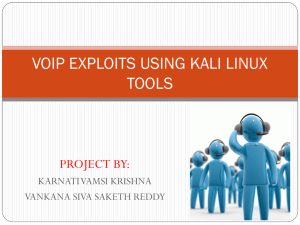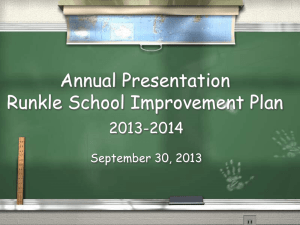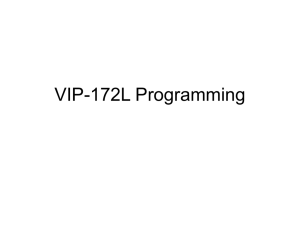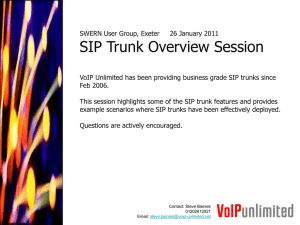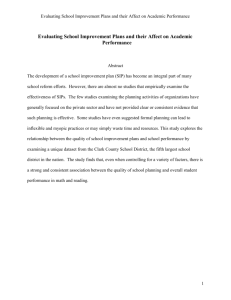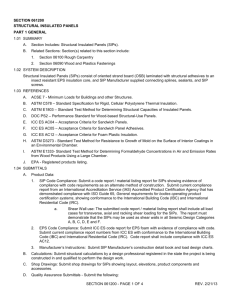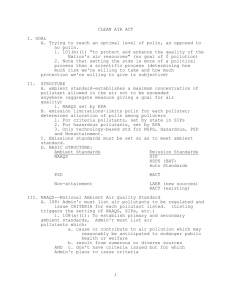Wood presentation
advertisement
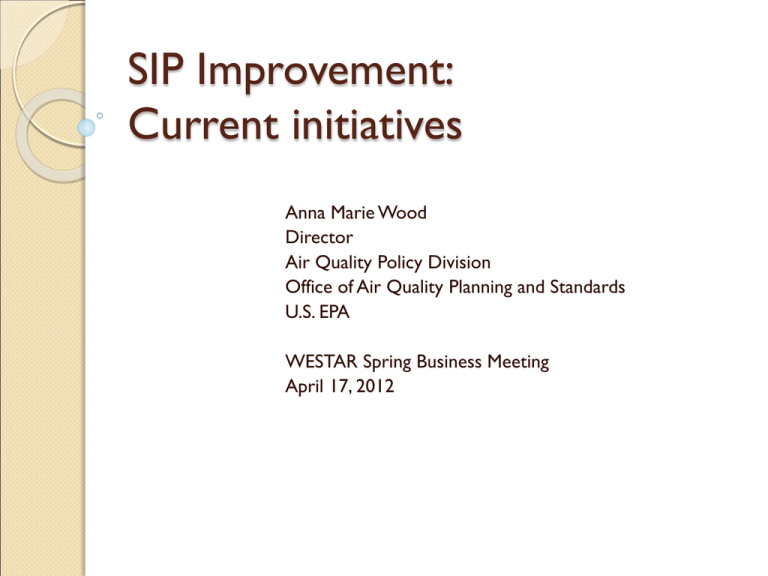
SIP Improvement: Current initiatives Anna Marie Wood Director Air Quality Policy Division Office of Air Quality Planning and Standards U.S. EPA WESTAR Spring Business Meeting April 17, 2012 Overview Questions What state/local concerns are we addressing? How are we addressing them? What are we ultimately trying to achieve? Where do we go from here? 2 What state/local concerns are we addressing? EPA has been engaging with states through different means over many months to better understand state concerns associated with SIP guidance, development, and processing. ◦ For example, the ECOS/NACAA SIP Reform Work Group started with a list of the 13 highest-priority potential SIP process reforms Through these various modes, we have come to identify two broad categories of issues: ◦ Consistent, timely, and efficient SIP processing ◦ Timely completion of EPA guidance documents, including state involvement in guidance development process 3 How are we addressing these issues? There are a number of efforts underway to address these issues ◦ Some have been completed and others are ongoing With input from states (via the ECOS/NACAA SIP Reform WG and others), we are focusing our efforts on: ◦ Developing tools to assist with implementing the NAAQS Focus is on SIP consistency and timely and efficient processing ◦ Providing for more timely issuance of guidance and involving states in the development of regulations and guidance that affect them as appropriate 4 Consistent, timely, and efficient SIP processing Consistency ◦ Consistency memo: addresses state submittal requirements, clarity on clean data vs. redesignation requests, and the use of letter notices (issued April 6, 2011) Addressed 4 of 13 issues identified by ECOS/NACAA SIP Reform Work Group ◦ Elevation memo: describes the process for EPA regional and HQ offices to raise issues related to broad categories of SIPs (e.g., infrastructure SIPs) in order to ensure they are addressed appropriately across the regions (memo forthcoming) Timeliness ◦ SIP Backlog Work Group Commitment to address over 200 backlogged SIPs by end of FY as part of KPI ◦ Menu of options to assist in processing SIP backlogs Efficiency ◦ SIP Kaizen process (e.g., ozone TSD, ozone cross-walk, and menu of control options) ◦ National SIP tracking database ◦ SIP dashboard Initially identified 20 SIP-related policy issues requiring resolution; only a handful remain 5 Timely completion of EPA guidance documents, including state involvement in guidance development We are planning to launch a full lifecycle analysis and action plan for implementation of the 2013 PM NAAQS Comprehensive, full cycle critical analysis ◦ A real program, rather than a “pilot” effort, that can be transferable and become core part of how we do business in the future ◦ Time horizon is from inception of new or revised NAAQS through attainment and beyond (SIP approvals, attainment findings, redesignations) EPA working with ECOS/NACAA SIP Reform Work Group to complete this analysis and associated work plan in CY2012 Will also serve as mechanism to address request by ECOS for EPA to conduct similar project 6 What are we trying to achieve? LCAP will serve as an important learning tool ◦ It represents an holistic, integrated attempt to bring together all of our previous efforts and lessons-learned with respect to SIP guidance, planning and processing ◦ State involvement every step of the way in LCAP Ultimate goal for LCAP ◦ Develop a roadmap to use as a tool for planning and carrying out implementation of future NAAQS 7 Steps to get started -- Visualizing successful implementation of the 2013 PM NAAQS Make a Big List of all the “things” necessary for success. ◦ CAA interpretations or EPA policies. ◦ Technical information, tools, and technical results. ◦ Work processes and decision making processes. ◦ Tools to speed administrative work. ◦ Goals and tracking systems. ◦ Communication practices. Answer questions for each item on the Big List. ◦ Timing. ◦ Will existing guidance do the job? ◦ How do we get it into the right hands so it can be used? ◦ Lessons from the past? ◦ Already underway vs. need to start a new effort? ◦ How to achieve quality with respect to the needs of the users? ◦ Competing priorities. Develop a plan of attack and a schedule for each item on the Big List. ◦ Accountable leaders. ◦ SIP Reform Work Group role. ◦ Involve eventual users. ◦ Use the expertise of staff in HQ offices, the Regions, and the state and local agencies. ◦ Tracking and progress reporting. 8 Where do we go from here? Initiate and complete work on the “Big List” for PM LCAP in summer 2012 ◦ Work with ECOS/NACAA SIP Reform Work Group and non-NACAA states for input Create work plan to address items on Big List, initiate certain actions and complete work by December 2012 ◦ Leverage tools and guidance already completed Bottom line: Use LCAP exercise to help develop roadmap for implementing future NAAQS 9 Questions or comments? 10


